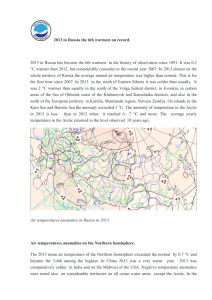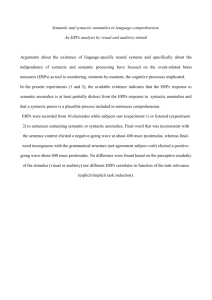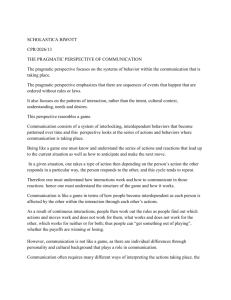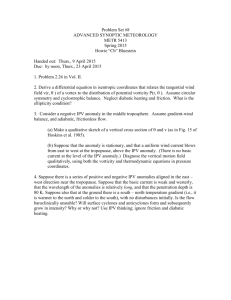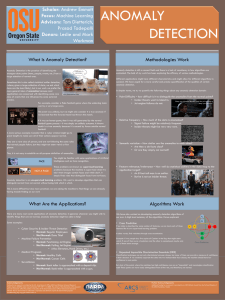D:\Desktop folders\A40\AD3\CUNY 2001\CUNY poster
advertisement
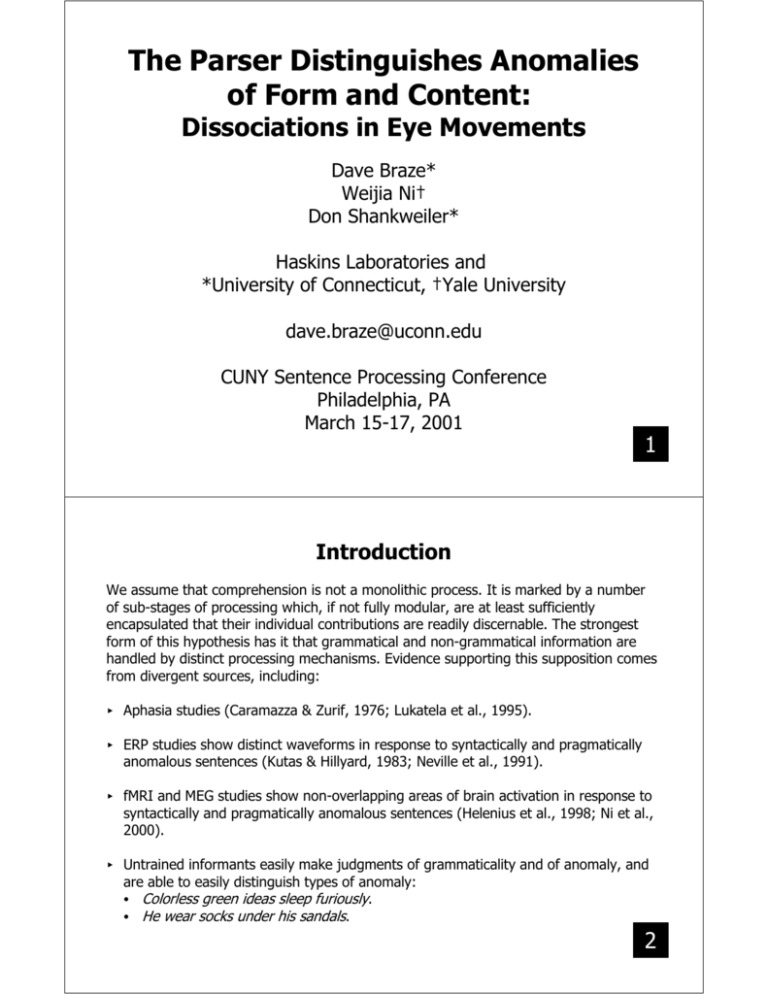
The Parser Distinguishes Anomalies of Form and Content: Dissociations in Eye Movements Dave Braze* Weijia Ni† Don Shankweiler* Haskins Laboratories and *University of Connecticut, †Yale University dave.braze@uconn.edu CUNY Sentence Processing Conference Philadelphia, PA March 15-17, 2001 1 Introduction We assume that comprehension is not a monolithic process. It is marked by a number of sub-stages of processing which, if not fully modular, are at least sufficiently encapsulated that their individual contributions are readily discernable. The strongest form of this hypothesis has it that grammatical and non-grammatical information are handled by distinct processing mechanisms. Evidence supporting this supposition comes from divergent sources, including: < Aphasia studies (Caramazza & Zurif, 1976; Lukatela et al., 1995). < ERP studies show distinct waveforms in response to syntactically and pragmatically anomalous sentences (Kutas & Hillyard, 1983; Neville et al., 1991). < fMRI and MEG studies show non-overlapping areas of brain activation in response to syntactically and pragmatically anomalous sentences (Helenius et al., 1998; Ni et al., 2000). < Untrained informants easily make judgments of grammaticality and of anomaly, and are able to easily distinguish types of anomaly: C Colorless green ideas sleep furiously. C He wear socks under his sandals. 2 Our interest is in further exploring whether the sentence processing mechanism shows characteristically distinct responses to grammatical and non-grammatical sources of information in the input. In Braze et al. (to appear) and Ni et al. (1998) we used contrasting morpho-syntactic and pragmatic anomalies as a probes for specific cognitive processes. Why Anomaly? Anomaly of different types can serve as litmus tests for particular types of processes. Sentences can be made anomalous in specific ways such that they serve to challenge different aspects of comprehension. For example, a sentence might be (a) pragmatically odd, (b) grammatically defective, or (c) semantically flawed. (a) (b) (c) The cats won’t usually bake (eat) the food. The cats won’t usually eating (eat) the food. The cats won’t usually eat the food tasty (cold). Further, anomaly can be easily localized to a single word within a sentence, allowing us to measure the response relative to that specific point. Given these characteristics, we can use anomalous test materials to disentangle the processes that take place as sentence comprehension unfolds in time. 3 Previous Work Using the technique of monitoring eye-movements during reading, Ni et al. (1998) and Braze et al. (to appear) contrasted sentences containing flaws in verbal morpho-syntax with other, grammatical sentences, depicting pragmatically odd subject-verb relationships, as shown below. Example Sentences < The wall will surely crack after a few years in this harsh climate. < The wall will surely cracking after a few years in this harsh climate. < The wall will surely bite after a few years in this harsh climate. NA SA PA Page 5 shows a breakdown of regressive eye-movement frequency by sentence region for each sentence type. Of interest is the dissociation in peak regression frequencies for the two anomaly types. Syntactic anomalies trigger regressions in the region containing the verb, followed by a return to baseline. Pragmatic anomalies, on the other hand, induce a spate of regressions at the ends of the sentences, but show no increase over controls at the region containing the verb. 4 5 Distribution of Target Regions for Regressions from Region 6 (percent and frequency) Target Region 1 2 3 4 5 non-anom. 14.1 9 17.2 11 4.7 3 20.3 13 43.8 28 Anomaly Condition syntactic pragmatic 10.2 8 21.7 30 25.6 20 29.7 41 7.7 6 21.7 30 16.7 13 10.1 14 39.7 31 16.7 23 Regions targeted by regressions launched from the ends of sentences (region 6) were also tabulated, as shown above. Target distribution for pragmatic anomalies was found to differ from both non-anomalous controls and syntactic anomalies. Target distributions for non-anomalous and syntactically anomalous sentences do not differ from each other. The split between non-anomalous sentences and syntactic anomalies on the one hand, and pragmatic anomalies on the other, parallels the split seen in the overall frequency of regressive eye-movements from the sentence final region. Braze et al. (to appear), and Ni et al. (1998) show that eye-movement indicators of syntactic and pragmatic processes each display a distinct signature, in keeping with the expectations generated by the ERP and neuroimaging studies. These data are consistent with the hypothesis of separate and dissociable processing 6 mechanisms, but there are questions that can be raised about the results. The present study is intended to address two of these questions. < Are the different regression peaks attributable to differences in degree of anomaly across anomaly types? < How well do the results generalize beyond the specific types of verb-based anomaly instantiated in the test sentences of Ni et al. (1998) and Braze et al. (in press)? (exemplar on page 4) We designed a pair of eye-movement experiments to explore these questions. Experiment 1 addresses the issue of degree of anomaly, using materials similar to those on page 4, but with an additional condition which contains simultaneous syntactic and pragmatic anomalies. Experiment 2 extends the paradigm of Ni et al. and Braze et al. to other grammatical and pragmatic relationships using noun-based morpho-syntactic and pragmatic anomalies. Method Subjects Twenty-eight undergraduate students were paid to participate. All were native speakers of English with vision they reported to be normal or corrected to normal with contact lenses. Participants had no knowledge of the purpose of the experiment and no prior exposure to the test materials. 7 Apparatus Eye-movements were recorded with a Skalar 6500 eye-tracker. The system uses infrared transducers positioned in front of the eye to detect eye-movements. The output is a continuously varying analog signal corresponding to gaze direction, which was digitized with a 1 ms sampling rate. A forehead rest and individually prepared bite bars were used to stabilize subjects’ head positions in order to minimize noise in the signal due to head movements. Sentences were presented on a computer monitor positioned 64 centimeters from the subjects’ eyes. Materials and Design Materials for each experiment are described below. For each experiment, stimulus sentences were blocked and counter-balanced such that subjects saw an equal number of stimulus items of each type. Stimulus sentences were interspersed with a like number of foils. 8 Experiment 1 Experiment 1 contrasts two hypotheses about the timing of peak regressive eyemovement frequency in pragmatically and syntactically deviant sentences. We hypothesize that different mechanisms are involved in processing grammatical and nongrammatical information. However, a plausible alternative explanation is that the observed difference in the placement of regression peaks is due to differences in degree of anomaly for each sentence type. The materials used here are similar to those of Braze et al. (to appear). The primary difference is the inclusion of a double anomaly condition, derived from a fully crossed design (syntactic anomaly X pragmatic anomaly). The purpose of combining the two types of anomaly within a single condition is to test whether effects due to each anomaly type remain distinguishable. Twenty-eight sentence sets on the following model were used as stimuli. Example Sentences < < < < The daisies were slowly wilting in the hot weather this afternoon. The daisies had slowly wilting in the hot weather this afternoon. The puddles were slowly wilting in the hot weather this afternoon. The puddles had slowly wilting in the hot weather this afternoon. NA SA PA DA 9 Predictions The separate mechanisms hypothesis predicts two peaks in regressions for double anomaly condition (DA), an early peak corresponding to that of syntactic anomalies (SA), and a late peak corresponding to that of pragmatic anomalies (PA). The degree of anomaly hypothesis predicts a single strong peak in regressive eyemovement frequency for the double anomaly condition, parallel to the syntactic anomaly condition. We might also expect that the peak for the DA condition should be of greater magnitude than that for the SA condition. Results Page 11 shows a plot of regional regression frequency for each sentence type. For the non-anomalous controls, syntactic, and pragmatic anomaly conditions, the pattern replicates that of Braze et al. (page 5). At sentence region 3 syntactic anomalies have far more regressions than either controls [F1(1,27)=47.75, p<0.0001; F2(1,27)=45.83 , p<0.0001] or pragmatic anomalies [F1(1,27)=41.60, p<0.0001; F2(1,27)=39.06, p<0.0001]. Of greater interest is the fact that double anomalies also show an increase in regressive eye-movements from the region containing the verb. Further, the increase is slightly less pronounced than that for syntactic anomalies. Doubly anomalous sentences induce more regressions than either controls [F1(1,27)=30.03, p<0.0001; F2(1,27)=27.98 , p<0.0001] or pragmatic anomalies [F1(1,27)=24.99, p<0.0001; F2(1,27)=22.66 , p<0.0001]. 10 11 At sentence region 6 pragmatic anomalies induce a somewhat greater proportion of regressions than controls [F1(1,27)=2.86, p<0.1], as do doubly anomalous sentences [F1(1,27)=5.71, p<0.05]. Double anomalies also induce more regressive eyemovements than sentences with syntactic anomalies alone [F1(1,27)=4.13, p<0.05]. Distribution of Regression Targets for Regressions from Region 6 (percent and frequency) Target Region 1 2 3 4 5 non-anom. 14.3 8 21.4 12 8.9 5 21.4 12 33.9 19 Anomaly Condition syntactic pragmatic 17.0 10 32.9 23 30.5 18 18.6 13 5.1 3 14.3 10 20.3 12 11.4 8 27.1 16 22.9 16 double 12.7 8 41.3 26 12.7 8 11.1 7 22.2 14 Target distribution for syntactically anomalous sentences does not differ from controls. Pragmatic anomaly differs from both controls [P2(4) = 8.57 , p = 0.073 ] and syntactic anomaly [P2(4) = 9.63, p < 0.05]. The target distribution for double anomalies also differs reliably from pragmatic anomalies [P2(4) = 11.68, p < 0.05]. 12 Discussion In experiment 1, observed patterns of eye-movements for syntactic and pragmatic anomalies replicate earlier work, both in terms of regression frequency and target distribution. In keeping with our prediction, based on the hypothesis that separate mechanisms are responsible for processing grammatical and non-grammatical information, doubly anomalous sentences show two peaks in regressive eye-movements relative to non-anomalous sentences. An early peak, consistent with syntactic anomaly, is followed by another at sentence end, consistent with pragmatic anomaly. Experiment 2 The purpose of experiment 2 is to test the generality of the patterns seen in previous work, where verb-based anomalies were used. Conceptually similar noun-based anomalies serve as test items. Materials incorporate both pragmatic anomalies and syntactic anomalies. The predicate relationship between adjective and noun is exploited to generate pragmatic anomalies, and the morphological dependency between determiner/quantifier and noun is manipulated to generate syntactic anomalies. Twenty-eight sentence sets on the following model were used as stimuli. 13 Example Sentences NA < Toni found two antique bottles on a shelf in the back of the shed. SA < Toni found an antique bottles on a shelf in the back of the shed. < Toni found two anxious bottles on a shelf in the back of the shed. PA Prediction We predict a replication of the general pattern in regressive eye-movements for syntactically and pragmatically anomalous sentences. Results In sentence region 3, syntactic anomalies generate more regressive eye-movements than either non-anomalous controls [F1(1,27)=6.89 , p=0.01 ;F2(1,27)=8.36 , p<0.01] or pragmatically anomalous sentences [F1(1,27)=5.54 , p=0.02 ;F2(1,27)=5.67, p=0.02]. Counter to our expectations, pragmatic anomalies do not show an increase in regressions at sentence end. 14 15 Distribution of Regression Targets for Regressions from Region 6 (percent and frequency) Target Region 1 2 3 4 5 non-anom. 10.6 7 24.2 16 18.2 12 1.5 1 45.4 30 Anomaly Condition syntactic pragmatic 26.2 16 11.3 6 26.2 16 41.5 22 19.7 12 20.8 11 11.5 7 9.4 5 16.4 10 17.0 9 Target distribution for controls differs from that of both syntactic and pragmatic anomalies (P2(4) = 17.86, p = 0.001; P2(4) = 13.79, p = 0.008), which do not differ from each other. 16 Discussion Noun-based syntactic anomalies show an early peak in regressions that quickly subsides. This pattern is similar to that seen with verb-based syntactic anomalies. On the other hand, we find no sentence ending peak in regressive eye-movement frequency for noun-based pragmatic anomalies. This contrasts with the situation for verb-based anomalies. However we do see that pragmatic anomaly influences regression target preference, consistent with verb-based pragmatic anomalies. Experiment 2, using noun-based anomalies, does show a dissociation in the processor’s use of syntactic and pragmatic information in the input, although details differ somewhat from the response to verb-based anomalies. 17 General Conclusions In confronting the sentence processor with form-based and meaning-based anomalies, we show that the eye-movement indicators of syntactic and pragmatic processes each display a distinct signature, in keeping with the expectations generated by ERP and neuroimaging studies, as well as the earlier eye-movement findings of Ni et al. (1998) and Braze et al. (to appear). The dual peak in regressive eye-movement frequency seen in the doubly anomalous sentences of experiment 1 supports the hypothesis of independent processing mechanisms for grammatical and non-grammatical information. The pattern of regressions seen in experiment 2, for noun-based morpho-syntactic anomaly, provisionally supports the generality of the syntactically induced early peak found in previous studies using verb-based anomalies. The similarity in eye-movement patterns in response to syntactic anomaly across experiments 1 and 2 lends support to our supposition that grammatical information is subserved by a specialized processing mechanism. In summary, this study confirms that eye-movement measures are sensitive to constraints invoked by a range of morpho-syntactic and pragmatic anomalies. Further, it confirms that the sentence processor’s immediate and subsequent responses to the two anomaly categories are distinct. Morpho-syntactic anomalies, whether noun-based or verb-based, invoke similar responses. Pragmatic anomalies seem to place less constraint on the sentence processor’s response. 18 References Braze, D., Shankweiler, D. P., Ni, W., and Palumbo, L. C. to appear. Readers' Eye Movements Distinguish Anomalies of Form and Content. Journal of Psycholinguistic Research. Caramazza, A., and Zurif, E. B. 1976. Dissociation of Algorithmic and Heuristic Processes in Language Comprehension: Evidence from Aphasia. Brain and Language 3:572-582. Helenius, P., Salmelin, R., Service, E., and Connolly, J. F. 1998. Distinct Time Courses of Word and Context Comprehension in the Left Temporal Cortex. Brain 121:11331142. Kutas, M., and Hillyard, S. A. 1983. Event Related Brain Potentials to Grammatical Errors and Semantic Anomalies. Memory and Cognition 11:539-550. Lukatela, K., Shankweiler, D. P., and Crain, S. 1995. Syntactic Processing in Agrammatic Aphasia by Speakers of a Slavic Language. Brain and Language 49:50-76. Neville, H. J., Nicol, J. L., Barss, A., Forster, K. I., and Garrett, M. 1991. Syntactically Based Sentence Processing Classes: Evidence from Event-Related Brain Potentials. Journal of Cognitive Neuroscience 3:151-165. Ni, W., Fodor, J. D., Crain, S., and Shankweiler, D. P. 1998. Anomalous Strings: Eye Movement Patterns. Journal of Psycholinguistic Research 27:515-539. Ni, W., Constable, T., Mencl, W. E., Pugh, K. R., Fulbright, R. K., Shaywitz, S. E., Shaywitz, B. A., and Gore, J. C. 2000. An Event-Related Neuroimaging Study: Distinguishing Form and Content in Sentence Processing. Journal of Cognitive Neuroscience 12:120-133. 19
